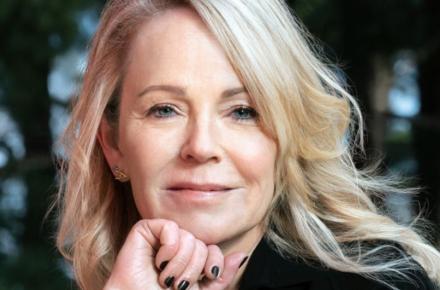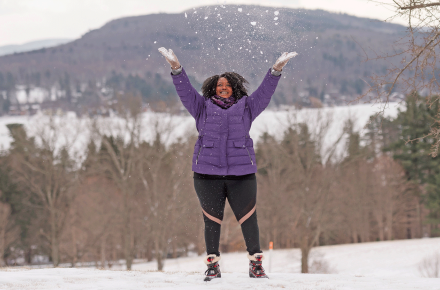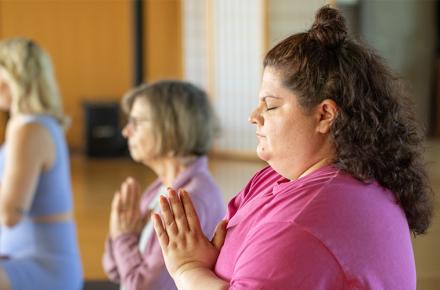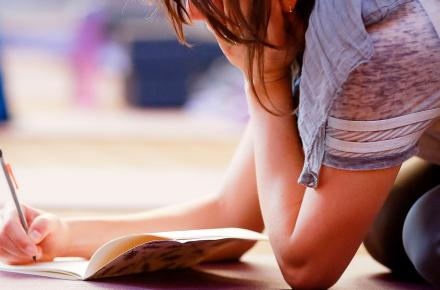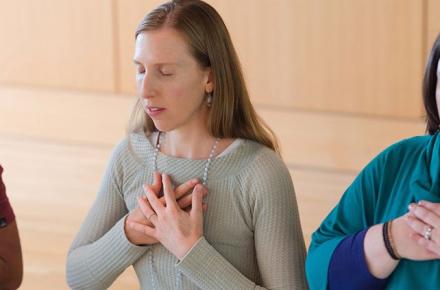Five Reasons Why We All Need to Play More
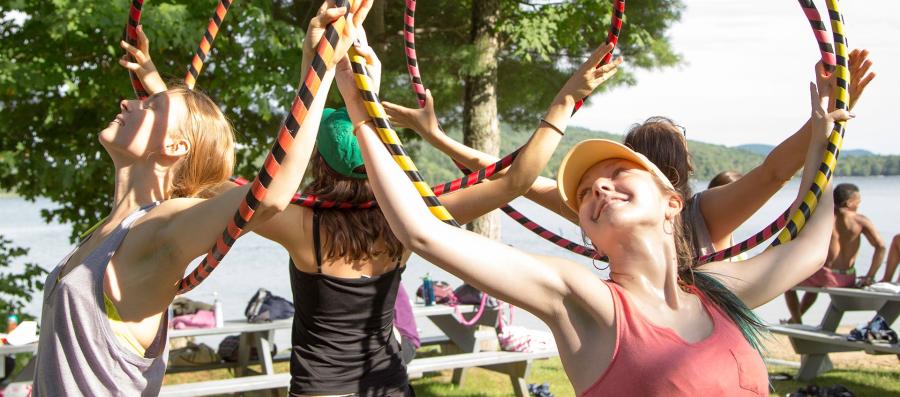
When was the last time you did something purely for the fun of it—not because you thought you should, or because it was good for you, or because someone else wanted you to? If it’s been a while, maybe it’s time to tune into your childlike spirit and bring play back into your life.
Toni Bergins has been teaching JourneyDance™ classes at Kripalu for more than 20 years, and it gives her regular doses of powerful, revitalizing play. “There’s not a week of my life that goes by without a big, crazy, joyful explosion,” Toni says. “Play helps you reclaim the part of your nature that’s light, fun, and expansive. In the play zone, we let go of the to-do list.”
For Toni, “play equals embodiment.” The creator of JourneyDance and its teacher trainings, as well as the Embodied Transformation Method, she believes passionately in dance and movement as approaches to growth and self-care.
For Michelle Dalbec, a teacher in the Kripalu School of Yoga and for Kripalu R&R, creativity is a go-to when she needs to refill her well. “Sometimes what I want, more than a nap or a massage or a good book, is to get my creativity flowing again,” she says. “That creates a levity that I need when my life feels too compressed.”
In Michelle’s case, that often takes the form of knitting, which has surprising physical and mental health benefits—including reduced heart rate and blood pressure, lower levels of the stress hormone cortisol, enhanced memory, and better cognitive abilities. According to Herbert Benson, a pioneer in mind-body medicine and author of The Relaxation Response, the repetitive action of knitting and crocheting can induce a relaxed state similar to that created by meditation and yoga.
Here are five more ways that play can boost our health and well-being.
Play gets us out of our heads and into the moment.
For most of us, meditation doesn’t feel like play—it's a practice, and practice is sometimes hard work. Play is a doorway into a different kind of present-moment experience.
“Children play, but they don’t know that’s what they’re doing,” Toni reflects. “Self-awareness takes you out of play—instead of being, you’re watching yourself being. Mindfulness is great for changing our thought patterns, but if you want to be more joyful, you have to do things that bring you more joy, not just change your thoughts.”
If you’re not sure what those things are, pay attention to the moments when you get so absorbed in something that you barely notice time passing. “Everyone has their own definition of fun, but one key to fun is that time flies by,” Toni says. “You’re so into it that you don’t even know what’s happening.” Positive psychologist Mihaly Csikszentmihalyi calls this “flow”—an effortless state of heightened focus and immersion in activities such as art, play, and work—which he considers to be the secret to happiness.
Play brings us together.
Play can be a very personal experience, but it’s also a way to connect to community, Michelle says. For example, in her Yoga Summer Camp program, the whole group creates a sand mandala together—bringing a collective vision to life.
Creating community is essential, because friendships outside the family contribute significantly to our happiness levels, especially in midlife. A study done in the United Kingdom found that the well-being of both men and women depends on having a wide circle of friends, with a lack of friends associated with significantly lower levels of psychological well-being.
When she teaches Yoga Summer Camp, Michelle says, “people arrive guarded and reserved or high-strung and stressed out. Over the week, with each activity, they start to relax and become less inhibited. By Friday, they’re lighthearted, laughing, exchanging phone numbers, and making plans to keep the playfulness going.”
Play creates new pathways in the brain.
When we do more playing and creating, and less analyzing and judging, we’re activating the right side of the brain, which doesn’t always get enough of a workout. Balanced brain activity supports neuroplasticity—the brain’s ability to change and evolve. In studies with rats, scientists have found that play supports new neural connections and changes the architectural structure of significant brain regions.
To change our brains, we first have to change our behavior. “Whatever you practice, you become,” Toni says. “If you want to become more playful, play more.”
Plus, playing gets us away from our devices, counteracting the nervous system arousal that results from too much screen time. “I love technology, and it’s amazing that we can work from anywhere—but we’re always plugged in,” Toni says. “Letting go of the phone is life changing.”
A playful attitude helps us avoid perfectionism.
“Being willing to take risks, to try new things, requires an element of playfulness,” says Michelle. When we approach something new and maybe a little bit intimidating—like hula-hooping or doing yoga on a paddleboard—it helps to go into it remembering that the only goal is to have fun.
When we’re playing, the stakes are low, and that helps to quiet perfectionist tendencies. There is no “right way” to play.
Play might even be the fountain of youth.
The elements of play—physical activity, creativity, and joy—are all proven to keep us young.
A study by the National Endowment for the Arts found that people aged 65 and up who participated in a weekly art program had better health, fewer doctor’s visits, and less medication usage at one- and two-year follow-ups, as compared to a control group. Another study found that older people who reported enjoying life were 28 percent less likely to die over the next six or seven years, while those who did not enjoy their lives were the most likely to die.
Physical activity, meanwhile, may slow down the brain’s aging process by as much as 10 years, according to MRI research involving 876 adults. (Yoga may also help reduce declines in brainpower as we get older.)
Michelle gets to see firsthand the anti-aging impact of play on the participants in her programs. “By the end of the week, they look like different people,” she says. “Their faces take on a quality of ease and levity and spaciousness. They literally look years younger.”
© Kripalu Center for Yoga & Health. All rights reserved.
























